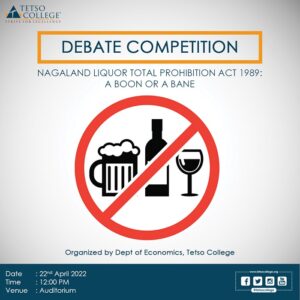
Department of Economics presents, Debate competition.
On the Topic
“Nagaland Liquor Total Prohibition Act 1989: A Boon or A Bane”
Objectives of The debate competition.
- To enhance the power of eloquence.
- Hone up communication skills & imbibe a sense of confidence.
- To help present ideas and thoughts process creatively & artistically.
- To instill the art of constructive debating.
Concept Note.
NLTP Act has always occupied the grey area since its inception. Today it stands at a point of contradiction in all spheres, be it on grounds of morality, economy, individual & community rights, legitimacy, implementations of its goals and objectives, health aspects and the debate still goes on and on…
Do come and witness Tetso students bringing up this grey area of NLTP to Black & White.
Judges for the Debate competition.
- Dr. Nouzhienino Peseyie.
Asst. Professor, Department of Psychology.
- Dr. Loina Shohe
Asst. Professor, Department of Sociology.
- Sir. Tokato K Sumi
Asst. Professor, Department of Political Science.
Tentative Date: 22nd of April (Friday)
Participants: 1 participant from each department. (In case of an odd numbering of participants our department will have one entry to make it even).
Debate Rubric:
|
Sl/No. |
Criteria |
1
Poor |
2
Average |
3
Good |
4
Excellent |
Score |
|
1. |
Content Organization & Clarity
*Viewpoints and responses are outlined clearly and orderly.
|
Unclear about debate topic & Weak Elaborations |
Seemed to understand some main points followed by rough choppy elaborations | Understood topic with smooth Elaboration | In-depth understanding of topic with Strong statements and smooth elaborations. |
/4 |
|
2. |
Use of Arguments
*Reason stated to support viewpoint
|
Few or no relevant reason given |
Some relevant reason given |
Most reasons stated and are relevant |
Most relevant reasons given in support |
/4 |
|
3. |
Use of Examples and Facts.
* Examples and facts are given to support reason. |
Few or no relevant supporting facts/ examples |
Some relevant examples/ facts given |
Many examples/ facts stated which are mostly relevant |
Many relevant supporting examples and facts to point.
|
/4 |
|
4. |
Use of Rebuttal
*Arguments made by the other teams are responded to and dealt with effectively. |
No effective counter arguments made |
Few effective counter arguments made |
Some effective counter arguments made. |
Many effective counter arguments made |
/4 |
|
5. |
Delivery/ Presentation style.
*Tone of voice, use of gesture s& level of enthusiasm are convincing to the audience |
Few style features; not convincing |
Few features were used convincingly |
All style features were used with some conviction |
All style features were used convincingly |
/4 |
Rule and Regulations:
- There will be two groups of speakers i.e. for the motion and against the motion.
- All the participants will be seated on the stage.
- The consecutive odds (1, 3, 5, 7…) speaker will speak for the motion while the consecutive evens (2, 4, 6, 8…) will speak against the same.
- The distinction of groups shall be purely decided by picking lots. (Date for the lot picking will be taken up as soon as the names of participants are filled in).
- Each participant will be given a total of 5 minutes.
- Each group has to send a representative for the summation, who will be allocated 2 minutes each.
- No participant will be allowed to deliver their respective speech by using any written or printed script. They can however write simple points or words on a small placard for reference.
- There will be 3 judges, each awarding a score of 20 points. The winner will be decided by adding up all the points allocated by the 3 judges.
- In case of a tie, the moderator will give points out of 10 which will lead to a final decision.
10. The winner and the runners up will be awarded with prizes and certificates.








